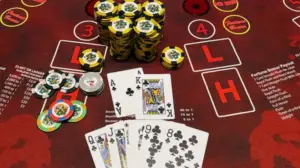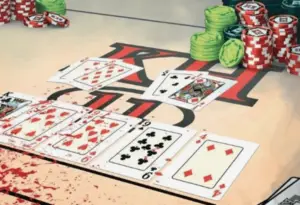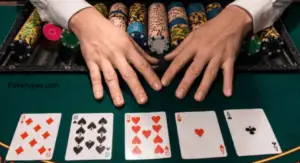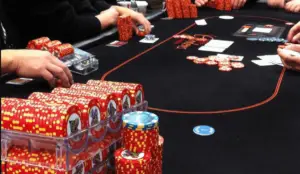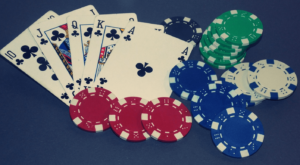Have you ever wondered why you keep losing so much at Texas Hold’em? Despite following all of the winning strategies, you still lose.
This means you are repeating the same mistakes or I would say blunders over and over again which results in your losing.
Therefore, it is important to understand what you should avoid when playing Texas Hold’em, regardless of whether you are a new player or an experienced player.
Sometimes they’re separate mistakes and sometimes they’re connected, leading to another, making it hard to stop.
Normally, people think only new players make these mistakes, but from my experience even professional players make them. So, no matter your poker level, you should be aware of them.
TV shows and movies like ‘Rounders’ may glamorize poker, but the truth is that Texas Hold’em requires mental discipline, strategy, and psychology.
The more you can identify and correct these mistakes, the more likely you are to succeed at the tables.
In this article, we will explore the top 10 common mistakes made in Texas Hold’em and provide valuable insights on how to avoid them. It’ll help you become a better opponent and refine your skills.
10 Blunders to Avoid in Texas Hold’em
1. Playing Too Many Hands Pre-Flop
Playing too many hands pre-flop is one of the most common and costly mistakes in Texas Hold’em.
This error occurs when players become impatient or overestimate their hand’s potential, leading them to play a wide range of starting hands.
The consequences of this loose play can be severe, as it often results in difficult post-flop situations, increased variance, and a steady drain on your chip stack.
Studies have shown that successful players typically play only 15-20% of hands at a full-ring table.
To tighten up your starting hand selection, focus on playing premium hands like pocket pairs (88+), strong-suited connectors (AKs-JTs), and high-card hands (AQ+) from the early position.
As you move to later positions, you can gradually expand your range to include more speculative hands.
For example, while you might fold K9o from under the gun, it could be a viable raise from the button. Remember, patience is key in poker, and folding pre-flop is often the most profitable play in the long run.
2. Ignoring Position
Poker players who know the rules and strategies of Texas Hold’em know that position is a key factor.
Being in a late position (on or near the button) gives you a significant advantage, as you will act last on every post-flop street, allowing you to make more informed decisions.
For example, a hand like KJ suited might be a fold from under the gun but a raise from the button.
Position affects decision-making by providing valuable information about opponents’ actions before you have to act.
When in an early position, play a tighter range of hands and be cautious with marginal holdings. In the middle position, you can expand your range slightly but still exercise caution.
Late position allows for more aggressive play and wider hand selection. Remember, the button is considered the most profitable position, winning an average of 7.5 big blinds per 100 hands in cash games.
3. Overvaluing Hands
Overvaluing hands is a common pitfall in Texas Hold’em, often leading to costly mistakes. Hands frequently overvalued include medium pocket pairs (77-JJ), top pair with a weak kicker, and drawing hands like flush or straight draws.
To accurately assess hand strength, consider the board texture, your position, and your opponents’ likely ranges.
For example, pocket jacks on a K-Q-7 flop are much weaker than on a 7-5-2 board. Studies show that players lose an average of 1.5 big blinds per 100 hands by overplaying medium-strength hands.
To avoid traps, be cautious with hands like top pair/weak kicker, especially when facing aggression.
Remember, your hand’s strength is relative to the board and your opponent’s actions. Practice hand reading and consider folding when faced with multiple bets or raises, especially on draw-heavy boards.
4. Failing to Adjust to Opponents
Failing to adjust to opponents is a critical mistake in Texas Hold’em that can significantly impact your win rate.
Reading opponents and adapting your strategy accordingly is essential for success. For example, against tight players, you should bluff more frequently and steal blinds aggressively.
When facing loose-aggressive opponents, tighten your starting hand requirements and look for opportunities to trap.
Table dynamics also play a crucial role; in a passive game, you can profitably play more hands, while in an aggressive game, you should be more selective.
By observing betting patterns, timing tells, and physical cues, you can gain valuable information about your opponents’ playing styles.
Skilled players often categorize opponents into types such as “nits,” “calling stations,” or “maniacs,” and adjust their strategy accordingly to exploit weaknesses and maximize profits.
5. Chasing Draws Incorrectly
Chasing draws incorrectly is a common mistake that can quickly deplete your bankroll. Understanding pot odds and equity is crucial for making profitable decisions when drawing.
Pot odds represent the ratio of the current pot size to the cost of a contemplated call, while equity is your chance of winning the hand.
For example, if you have a flush draw on the flop, you have about 35% equity. If the pot is offering better than 2-to-1 odds, it’s mathematically correct to call.
However, it’s important to consider implied odds and your opponent’s tendencies. Studies show that players lose an average of 1.5 big blinds per 100 hands by incorrectly chasing draws.
To balance risk and reward, only chase draws when the pot odds exceed your equity, and be willing to fold when the math doesn’t support calls.
Remember, successful players typically play only 15-20% of hands, so patience is key in poker.
6. Not Paying Attention to Board Texture
Board texture is a crucial factor in Texas Hold’em that significantly impacts hand strength and betting strategies.
Different board textures can dramatically alter the relative strength of hands and the range of possible holdings.
For example, on a dry board like K-7-2 rainbow, the top pair is usually strong, while on a wet board like Q-J-T with two suited cards, even two pairs can be vulnerable.
Studies show that players who actively adjust their strategy based on board texture can increase their win rate by up to 15%.
To read possible hands, consider the likelihood of straights, flushes, and sets based on the community cards.
Adjust your betting patterns accordingly; for instance, bet larger on wet boards to protect strong hands and deny equity to draws. On dry boards, smaller bets can often achieve the same goals while risking less.
7. Being Predictable
Being predictable in Texas Hold’em can be a costly mistake that skilled opponents will readily exploit. Playing a one-dimensional game makes you vulnerable to counter-strategies and reduces your overall profitability.
To keep opponents guessing, it’s crucial to mix up your play by varying your betting patterns, hand selection, and post-flop decisions.
For example, occasionally bluff with weak hands and slow-play strong ones to balance your range.
Balancing your range involves playing a diverse selection of hands from each position, making it difficult for opponents to put you on a specific hand.
For instance, you might 3-bet with both premium hands like AA, and speculative hands like 78s from the button.
Your long-term profitability increases when you incorporate unpredictability into your game. Remember, poker is a game of incomplete information, and maintaining mystery is key to success.
8. Poor Bankroll Management
Poor bankroll management is one of the most common pitfalls in poker, often leading to financial ruin for players.
Setting appropriate stakes is crucial; a general rule is to have 20-30 buy-ins for cash games and 100+ buy-ins for tournaments.
For example, with a $1,000 bankroll, you should play no higher than $0.05/$0.10 cash games or $5 tournaments.
Long-term thinking is essential, as studies show that even skilled players can experience downswings of 20-30 buy-ins due to variance.
To manage swings and variance, implement strategies like the “stop-loss” rule (quitting after losing 2-3 buy-ins in a session) and the “shot-taking” rule (moving up in stakes only when your bankroll is 20% above the minimum requirement).
Additionally, tracking your results and regularly reviewing your bankroll can help you make informed decisions about when to move up or down in stakes.
Remember, successful players typically play only 15-20% of hands, emphasizing the importance of patience and discipline in bankroll management.
9. Misusing Bluffs
Misusing bluffs is a common mistake that can quickly erode your chip stack. Effective bluffing requires careful consideration of various factors, including board texture, opponent tendencies, and your table image.
To bluff effectively, choose spots where your story makes sense, such as representing a missed draw on the river.
Good bluffing opportunities often arise when the board favors your perceived range, like betting on an ace-high flop after raising pre-flop.
Recognize that bluffs are more likely to succeed against tight players and in heads-up pots. Avoid excessive bluffing, as the optimal bluffing frequency is typically lower than many players assume.
For example, on the river, a balanced strategy often involves bluffing only about one-third of the time.
By carefully selecting your bluffing spots and avoiding poorly timed attempts, you can significantly improve your overall win rate.
10. Letting Emotions Control Your Play
Poker is a game where emotions can lead to big losses. Tilting, or making irrational decisions due to negative emotions, affects even experienced players. Studies show that tilting episodes can result in a 20-30% decrease in win rate.
To maintain composure, practice techniques like deep breathing, positive self-talk, and focusing on the present moment.
For example, count to ten before making decisions after a bad beat. Taking regular breaks is crucial; research indicates that players who take 5-minute breaks every hour perform better and tilt less frequently. Self-reflection is also vital for improvement.
Analyze your play after sessions, focusing on emotional reactions and decision-making processes. Keep a poker journal to track patterns and progress.
Conclusion
Getting good at Texas Hold’em takes more than just knowing the rules; you have to avoid common pitfalls and keep refining your strategy.
We’ve talked about ten mistakes you should avoid, from playing too many hands pre-flop to letting your emotions rule.
The more you address these issues, the better your game will be and the more likely you’ll be to win.
Remember, even professional players make mistakes, but what sets them apart is their ability to learn and adapt.
Make sure you learn from each mistake, analyze your play objectively, and keep improving. With dedication and practice, you can elevate your Texas Hold’em skills and become a formidable opponent.



































